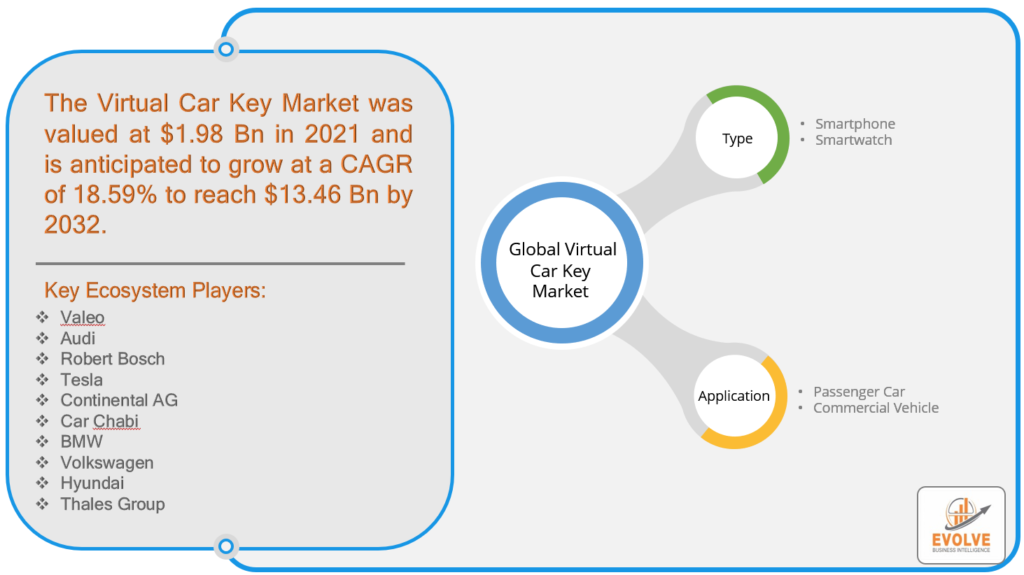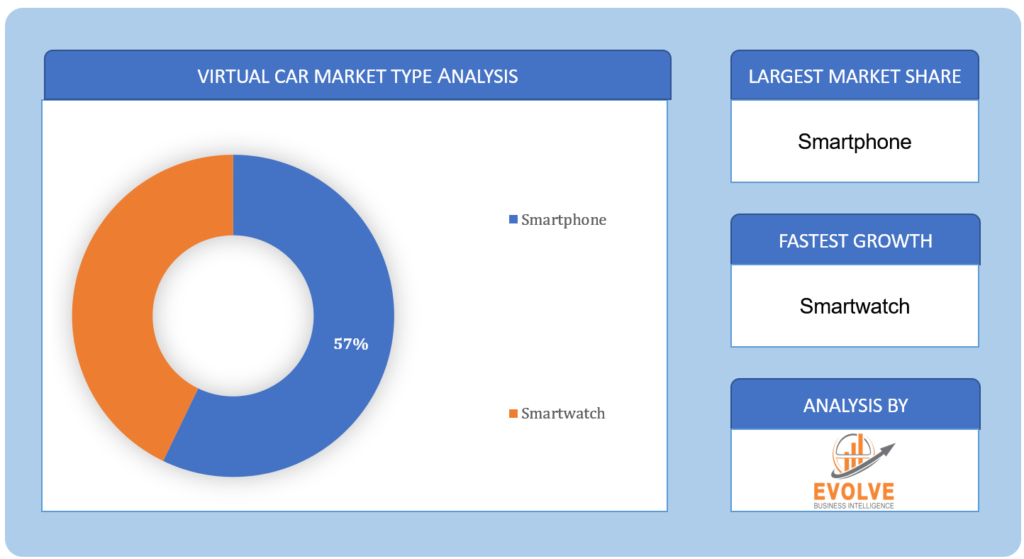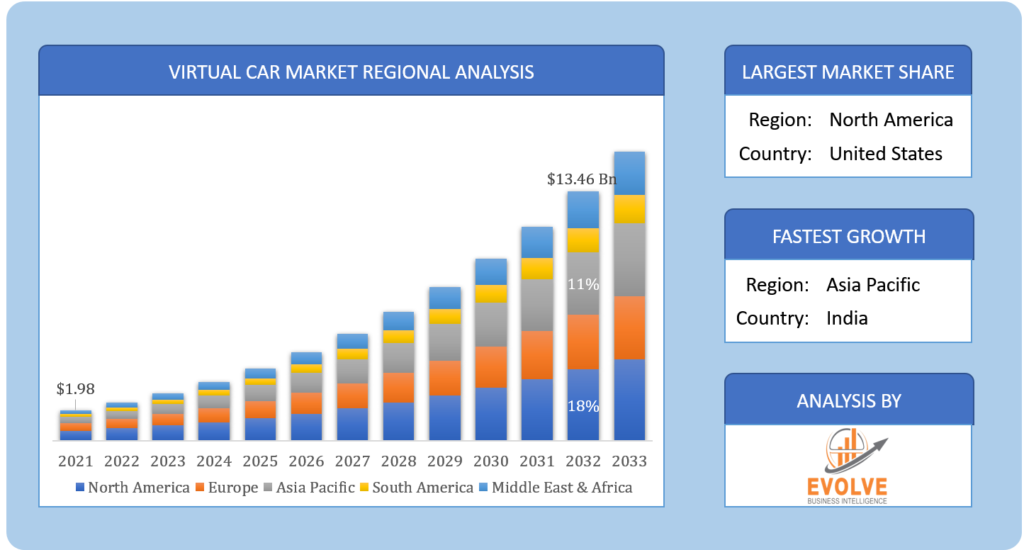Virtual Car Key Market Analysis and Forecast 2020-2032
$1,390.00 – $5,520.00Price range: $1,390.00 through $5,520.00
Virtual Car Key Market Research Report: Information ByType (Smartphone, Smartwatch), By Application (Passenger Car, Commercial Vehicle),and Region — Forecast till 2032
PRESS RELEASE:https://evolvebi.com/the-global-virtual-car-key-market-is-estimated-to-record-a-cagr-of-around-18-59-during-the-forecast-period/
[vc_row][vc_column width=”2/3″][vc_column_text woodmart_inline=”no” text_larger=”no”]
Virtual Car KeyMarket Overview
Virtual Car Key Market Size is expected to reach USD 13,465.8 Million by 2032. The Virtual Car Key industry size accounted for USD D 1,988.4 Million in 2021 and is expected to expand at a compound annual growth rate (CAGR) of 18.59% from 2020 to 2032.The virtual car key market encompasses the creation and acceptance of electronic keys for automobiles, which can be accessed and utilized through mobile devices like smartphones or smartwatches. These keys serve as a substitute for traditional physical keys and offer advantages like augmented safety features, remote access and sharing, and other benefits. The market comprises enterprises engaged in producing, developing, and distributing virtual car keys, as well as those involved in related technologies and services like connected cars and mobile apps. With the expanding adoption of connected cars and the rising popularity of mobile-based services, the market is poised to experience substantial growth in the foreseeable future.
 COVID-19 Impact and Post-COVID Scenario
COVID-19 Impact and Post-COVID Scenario
The virtual car key market has experienced a Negative impact due to the COVID-19 pandemic. While the pandemic has accelerated the adoption of contactless technology, including virtual car keys, as people strive to reduce physical contact and prevent the spread of the virus, it has also disrupted supply chains and manufacturing operations, affecting the development and production of virtual car keys. The shutdown of car manufacturing plants and reduced demand for new vehicles have further slowed down the adoption of virtual car keys, particularly in the short term.
Global Virtual Car Key Market Growth Factors
-
Increasing adoption of connected cars
The virtual car key market is being driven by the increasing adoption of connected cars, which offer several advantages such as enhanced safety and security, improved convenience, and access to a wide range of features and services. As connected cars become more popular, virtual car keys are becoming an essential part of the connected car ecosystem, enabling users to access and manage their vehicles remotely through their mobile devices. With virtual car keys, users can lock and unlock their cars, start the engine, adjust temperature and lighting settings, and perform other functions, all from their smartphones or other mobile devices. The convenience and ease of use provided by virtual car keys have made them an attractive option for many consumers and are expected to drive the growth of the virtual car key market in the forecasted period.
Global Scoliosis Market Restraining Factors
- Deficiency Of Awareness About The Mobile App Among Consumer
The deficiency of awareness among consumers about virtual car keys and the associated mobile app is a significant challenge for the market. Many people do not realize the importance of the mobile app and how it can enhance their lifestyle by providing convenient access to their vehicles. While the mobile app for virtual car keys is available on the Google Play Store and app store in Apple iOS, the lack of promotion among users in developing countries is expected to limit the market growth.
Global Scoliosis Market Opportunity Analysis
-
Increasing demand for contactless solutions
The increasing demand for contactless solutions due to the COVID-19 pandemic has created an opportunity for virtual car key manufacturers. As people look for ways to reduce physical contact and limit the spread of the virus, virtual car keys have become a more appealing option for consumers. The convenience and safety of virtual car keys have become more apparent, and this trend is expected to continue even after the pandemic subsides. Virtual car key manufacturers can leverage this opportunity by developing and promoting their touchless solutions to a wider audience.
Global Scoliosis Market Segment Analysis
 The Smartphone segment is expected to hold the largest market share
The Smartphone segment is expected to hold the largest market share
Based on the Type, the Virtual Car Key market is segmented based on Smartphone, and Smartwatch. The Smartphonesegmentis expected to hold the largest market share, This is due to the widespread adoption of smartphones globally, as well as the greater functionality and larger screen size of smartphones compared to smartwatches. Smartphones offer greater convenience and accessibility, allowing users to access and manage virtual car keys more easily. Additionally, the development of mobile apps for virtual car keys has also contributed to the growing popularity of smartphone-based virtual car keys. The increasing demand for connected cars and smart mobility solutions is expected to further boost the adoption of virtual car keys via smartphones in the imminent years.
The passenger car segment is expected to hold the largest market share
Based on Application, the global Virtual Car Key market has been divided intoPassenger Car and Commercial Vehicle. The passenger car segment is expected to hold the largest market share. This is due to the higher adoption of virtual car keys in the passenger car segment, driven by the increasing demand for connected cars and smart mobility solutions among consumers. Virtual car keys offer several advantages in passenger cars, such as convenience, ease of use, enhanced security, and the ability to remotely access and share keys. Moreover, the rising popularity of ride-sharing and car-sharing services is also expected to drive the growth of virtual car keys in the passenger car segment. The commercial vehicle segment is also expected to witness significant growth in the forecasting years.
Global Virtual Car Key Market, Segmental Chart
 Virtual Car Key Market Regional Analysis
Virtual Car Key Market Regional Analysis
Based on region, the global Virtual Car Key market has been divided into North America, Europe, Asia-Pacific, theMiddle East & Africa, and Latin America. North America is projected to dominate the use of the Virtual Car Key market followed by the Asia-Pacific and Europe regions.
Regional Coverage:
- North America
- US
- Canada
- Mexico
- Europe
- UK
- Germany
- France
- Italy
- Spain
- Benelux
- Russia
- Rest of Europe
- Asia Pacific
- China
- Japan
- South Korea
- Indonesia
- Austalia
- Malaysia
- India
- Thailand
- Rest of Asia Pacific
- Latin America
- Brazil
- Argentina
- Rest of Latin America
- Middle East & Africa
- Saudi Arabia
- UAE
- Egypt
- South Africa
- Rest of Middle East & Africa
Asia Pacific Market
The Asia Pacific region is one of the dominant regions in the Virtual Car Key market. The region has a large population and a growing middle class with increasing purchasing power. This has led to a significant increase in demand for vehicles in the region. Additionally, many countries in the Asia Pacific region are investing heavily in infrastructure development, including smart cities and connected vehicles, which are expected to further drive the demand for virtual car keys. Moreover, the increasing adoption of mobile-based services and the growing smartphone and smartwatch penetration in the region are also contributing to the growth of the Virtual Car Key market in Asia Pacific.
North America Market
North America is one of the major regions in the global Virtual Car Key market and holds a significant market share. The region is home to several key players in the virtual car key market and has a high adoption rate of connected cars and mobile-based services. The increasing demand for contactless solutions and advanced security features in the region is also driving the growth of the virtual car key market. Additionally, the region has a strong focus on technological advancements and innovation, which is expected to contribute to the growth of the virtual car key market in the coming years.
Competitive Landscape
The competitive Landscape include key players (tier 1, tier 2, and local) having their presence across the globe. Companies such as Valeo, Audi, Robert Bosch, Tesla, and Continental AG are some of the leading players in global Virtual Car Key market. These players have adopted partnership, acquisition, expansion, new product development, among others as their key strategy.
Key Market Players:
- Valeo
- Audi
- Robert Bosch
- Tesla
- Continental AG
- Car Chabi
- BMW
- Volkswagen
- Hyundai
- Thales Group
Market Share Acquisition Strategies: Analysis of Key Approaches Employed by Top Players:
In August 2021,Continental AG announced that it had acquired a Stake in Kopernikus Automotive,Artificial Intelligence Specialist for Automated Parking.
In November 2021, Volkswagen has a partnership with EIT InnoEnergy to help innovate technologies and businessmodels accomplish economic breakthroughs that will contribute tothe decarbonization of the transport segment and accelerate theshift to electromobility.
Report Scope:
Global Virtual Car Key Market, by Type
- Smartphone
- Smartwatch
Global Virtual Car Key Market, by Application
- Passenger Car
- Commercial Vehicle
Global Scoliosis Treatment Market Synopsis:
| PARAMETER | VALUE |
Market Size |
· 2021: USD 1,988.4Million· 2033: USD 13,465.8Million |
Growth Rate |
· First 5 Years CAGR (2022–2026): XX%· Last 5 Years CAGR (2027–2032): XX%· 10 Years CAGR (2022–2032): 18.59% |
Key Market Drivers |
· Increasing adoption of connected cars |
Key Market Restraints |
· Deficiency Of Awareness About The Mobile App Among Consumer |
Market Opportunities |
· Increasing demand for contactless solutions· |
Key Market Players |
· Valeo· Audi· Robert Bosch· Tesla· Continental AG· Car Chabi· BMW· Volkswagen· Hyundai· Thales Group· Thales Group· International Business Machines Corporation |
REPORT CONTENT BRIEF:
- High-level analysis of the current and future Virtual Car Key market trends and opportunities
- Detailed analysis of current market drivers, restraining factors, and opportunities analysis in the future
- Historical market size for the year 2021, and forecast from 2022 to 2032
- Virtual Car Key market share analysis for each segment
- Competitor analysis with a comprehensive insight into its product segment, financial strength, and strategies adopted.
- Identifies key strategies adopted by the key players including new product development, mergers and acquisitions, joint ventures, collaborations, and partnerships.
- To identify and understand the various factors involved in the global Virtual Car Key market affected by the pandemic
- To provide year-on-year growth from 2022 to 2032
- To provide short-term, long-term, and overall CAGR comparison from 2022 to 2033.
- Provide Total Addressable Market (TAM) for the Global Virtual Car Key Market
[/vc_column_text][/vc_column][vc_column width=”1/3″][vc_column_text woodmart_inline=”no” text_larger=”no”][html_block id=”3961″][/vc_column_text][vc_wp_text]
Press Release
[rpwe limit=”10″ thumb=”true”]
[/vc_wp_text][vc_posts_slider count=”5″ interval=”3″ slides_content=”teaser” slides_title=”1″ posttypes=”product”][/vc_column][/vc_row][vc_row][vc_column][vc_column_text woodmart_inline=”no” text_larger=”no”]
Frequently Asked Questions (FAQ)
[sp_easyaccordion id=”12750″][/vc_column_text][/vc_column][/vc_row]





